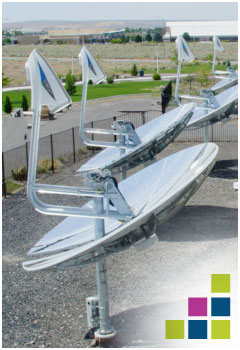South Africa has been blessed with abundant and high quality solar radiation and it is therefore logical that solar power generation is high on the government's priority list of preferred renewable technologies. Solar power technologies can be loosely classified as Photovoltaic (PV) and Concentrated Solar Power (CSP). PV in turn can be classified as crystalline silicon cells, thin film technology and concentrated PV (CPV). The most well-known thermal CSP technologies are trough, tower and dish Stirling. The advantage of CSP technology compared to silicon 3nd thin film PV is higher conversion efficiencies and therefore lower generation costs.
Concentrated solar power (CSP) is systems that use lenses or mirrors and tracking systems to concentrate a large area of sunlight, or solar thermal energy, onto a small area. Electrical power is produced when the concentrated light is converted to heat which drives a heat engine (usually a steam turbine) connected to an electrical power generator.
Concentrating technologies exist in four common forms, namely parabolic trough, concentrating linear fresnel reflector, and solar power tower and dish Stirling. Each concentration method is capable of producing high temperatures and correspondingly high thermodynamic efficiencies, but they vary in the way that they track the sun and focus light. Due to new innovations in the technology, concentrating solar thermal is becoming more and more cost-effective.
A Stirling engine is a heat engine operating by cyclic compression and expansion of helium or other gas, the working fluid, at different temperature levels such that there is a net conversion of heat energy to mechanical work. Like the steam engine, the Stirling engine is traditionally classified as an external combustion engine, as all heat transfers to and from the working fluid take place through the engine wall. This contrasts with an internal combustion engine where heat input is by combustion of a fuel within the body of the working fluid. Unlike a steam engine's (or more generally a Rankine cycle engine's) usage of a working fluid in both its liquid and gaseous phases, the Stirling engine encloses a fixed quantity of permanently gaseous fluid such as air.
Typical of heat engines, the general cycle consists of compressing cool gas, heating the gas, expanding the hot gas, and finally cooling the gas before repeating the cycle.
Originally conceived in 1816 as an industrial prime mover to rival the steam engine, its practical use was largely confined to low-power domestic applications for over a century.
The Stirling engine is noted for its high efficiency (up to 40% in practice), quiet operation, and the ease with which it can use almost any heat source. This compatibility with alternative and renewable energy sources has become increasingly significant as the price of conventional fuels rises, and also in light of concerns such as peak oil and climate change. This engine is currently exciting interest as the core component of dish Stirling concentrated solar power systems, providing the highest conversion efficiency of any thermal solar power generation system.
|

|




